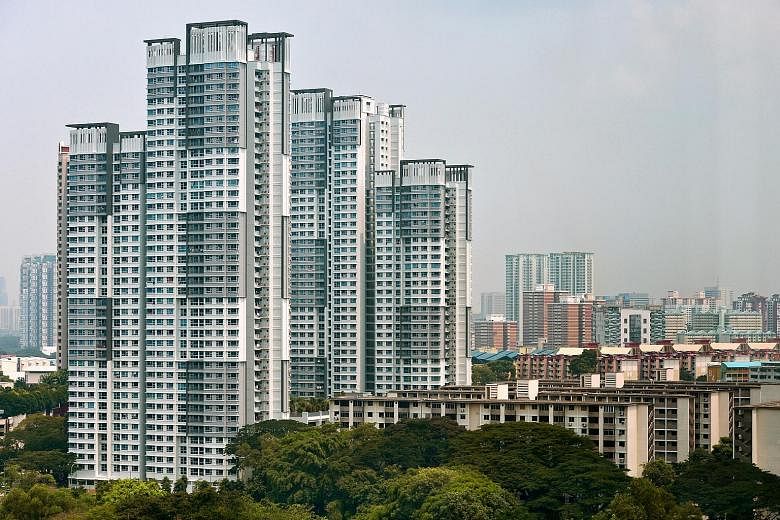It has been nearly a decade since former Ang Mo Kio Avenue 3 resident Victor Spencer received a letter from the Housing Board telling him that his home has been picked for the Selective En Bloc Redevelopment Scheme (Sers).
He remembers the buzz among his neighbours - Sers meant a windfall for residents, so long as they vacated their homes and handed over the keys to the Government, which needed to redevelop the land.
But today, six years after Mr Spencer and his family of four moved to their replacement flat at Teck Ghee Vista, his old home is still standing. A public tender for its demolition was called only this year.
Says Mr Spencer, 66, a petroleum surveyor: "It is quite strange to me that they would have us move out of our homes, only to leave the blocks there. Many of us would have preferred to move at a later time - this was a childhood home for us."
Sers, introduced in August 1995, is the Housing Board's version of selling en bloc public housing sitting on land with high redevelopment potential.
It is also highly selective, with only 4 per cent of HDB flats, or 80 sites, identified for Sers so far. Residents cannot initiate collective sales on their own.
While redevelopment happens at a quick pace after a condo's successful sale en bloc as eager developers look to reap profits at the earliest opportunity, some Sers projects can take a far longer time before actual demolition and redevelopment.
The process can take between a year and seven years, as in the case of the Dover Road Sers, based on four demolition tenders seen by The Sunday Times this year.
Of the 80 sites selected for Sers so far, 61 projects have been demolished, three are undergoing demolition and five have yet to be fully vacated, says an HDB spokesman.
The remaining 11 sites are still awaiting demolition.
Says the spokesman: "Generally, Sers blocks will be demolished after all residents have moved out as the land they occupy is earmarked for redevelopment. However, actual redevelopment will only proceed after taking into consideration the prevailing market conditions when the site is fully vacated,as well as the Government's redevelopment priorities then."
In the meantime, the empty sites may be converted to interim housing uses such as the Parenthood Provisional Housing Scheme and Interim Rental Housing, or other uses as decided by the Government, he adds.
While sales en bloc in the private sector displace the original communities built up over the years, Sers keeps them mostly intact, with many residents relocating to the same replacement build-to-order site offered by HDB.
But sentiment depends on who you speak to. Most younger home owners interviewed shared how the benefits of getting a new home with a fresh lease at a very favourable price under Sers outweighs feelings of loss for the old home.
Residents who lived at the same place for decades tend to be more averse to the idea of displacement.
SMRT operations officer Lau Boon Hwa, 44, who moved out of his Sers flat in Block 1A, Woodlands Central to a replacement site in Admiralty last year, says his three young children - aged five, seven and 10 - are excited about their new home.
NOSTALGIC VISITS BACK
Like many others, Mr Lau is upbeat about Sers - he was compensated $285,000 for a three-room flat that he bought for $145,000 nine years ago.
But he and his wife would sometimes head back to their old home to "drink the kopi" there.
The sleepy estate of Woodlands Central, once hailed as the gem of the north and boasting 24-hour eateries, a cinema and a huge department store, will soon be demolished to make way for the expanding Woodlands Checkpoint nearby. A tender for demolition contractors was called last week.
Says Mr Lau: "I still see the same old faces in my new place, but some of the community spirit would definitely have rubbed off here and there."
Near the old JTC-built blocks at 167 to 172, Boon Lay Drive, which was marked for Sers in 2011, former residents can still be seen meeting at the hawker centre or food courts. Retired driver Loo Kim Tian, 60, who now lives in Jurong West Central, still walks to the old hawker centre daily despite the convenience of Jurong Point shopping mall next to his new home.
"A lot of people say the new place is beautiful, but I still prefer the old place because it is bigger and less noisy. I miss it a lot - I lived there for 40 years," says Mr Loo, who moved in this year.
Likewise, Mr Spencer, a former long-time resident of Ang Mo Kio Avenue 3, misses the days of football with his mates at the field there. They still meet in Bishan-Ang Mo Kio Park for football, but the father of two young daughters says the feeling is different.
"There were gains (with Sers), of course, because I didn't pay much for a new flat with a fresh lease. But at the end of the day, I lost the sense of rootedness, identity and context which I can't pass on to my daughters now," he says.


